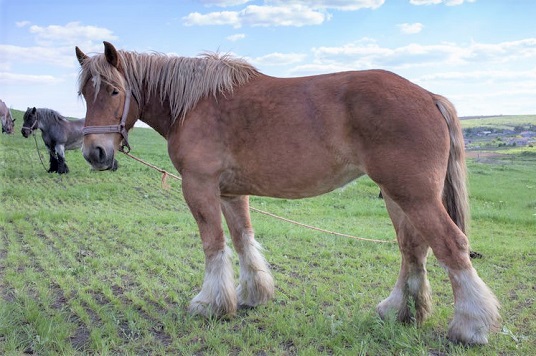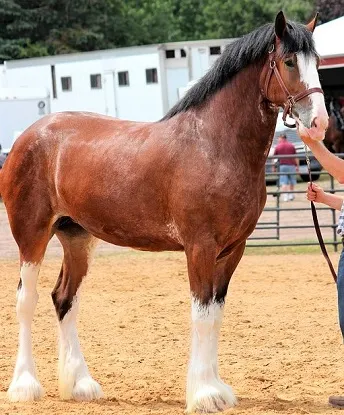Belgian horses and Clydesdales are among the most popular draft breeds. These gentle giants are famous for their incredible strength and beauty, but some differences set the two breeds apart.
Belgian horses are bigger than Clydesdales, as they weigh between 1,800-2,400 pounds and stand between 16-18 hands tall. Though Clydesdales are often a similar height or even taller, standing at 17-18 hands tall, they typically weigh less. The average Clydesdale weighs between 1,600-2,300 pounds.
Belgian horses often have a slightly heavier and more muscular build than Clydesdales. Known for their incredible strength, Belgians are often used in pulling contests and are considered by many to be the strongest breed of horse in the world.
Belgian Horses vs. Clydesdales
Belgian horses are originally from the Brabant region of Belgium. They were once mighty warhorses before being bred to have a heavy build for agriculture work.
They first arrived in American during the 1800s from Brabant, also known as Belgian Heavy Draft. The American Belgian horse went on to be bred to have a lighter, taller build than the bulky Brabants, which have the classic Belgian style. Belgians and Brabants were recorded into the same registry up until recently before splitting into two separate ones. Now, all Brabant horses are Belgians, but not all Belgians are Brabants.
Clydesdale horses are a British horse breed originally from the county of Lanarkshire in Scotland. Developed in the 18th century, these strong and stylish horses were bred to pull heavy cargo and work in agriculture.
They were first brought to America in the 1840s, originally pulling hitches due to their high-stepping trot and power. In the 1930s, they began their famous role as the hitch horses for Anheuser Busch. Today the world-famous Budweiser Clydesdales are admired by people worldwide.

Belgian Draft. Credit: indigolotos / 123RF.com Physical Similarities and Differences
Both of these incredible draft breeds are known for their large, muscular builds. However, Belgians tend to have bigger, heavier builds, whereas Clydesdales tend to be slightly smaller, more refined builds.
Belgian horses have strong, muscular bodies, large yet stylish heads, well-arched necks and strong legs. Unlike Clydesdales, they only have light feathering on their legs. They are most commonly chestnut or roan in color with a white or blonde mane and tail.
Clydesdale horses have arched necks, sloping shoulders, powerful legs and large, round hooves. Their heads are wide, yet proportional, with a flat face or occasionally a slightly Roman nose and expressive eyes.
Clydesdales are typically bay in color with long, silky white feathers on their legs, but they can also be black, brown, chestnut or roan. Like Belgians, they often have docked tails.
Temperament
Both of these breeds have easy-going, friendly dispositions. They are hardworking horses, with good mindsets that make them eager to please.
Both Clydesdales and Belgians are popular driving horses and are even gaining popularity as riding horses. Belgians still do agriculture work and are popular for pulling competitions. Both breeds are gentle, calm and cooperative in nature.
Clydesdales Size Comparison to Regular Horses
Next to a light horse, such as a Quarter horse, a Clydesdale will seem huge. With the average Quarter horse standing between 14-16 hands, a Clydesdale is often one to four hands taller.
Not only will a Clydesdale be taller, but they will weigh much more. With Clydesdales weighing between 1,600-2,300 pounds, they can be double the weight of a Quarter horse that typically weighs between 900-1,200 pounds.
Compare a Clydesdale with a Shetland pony and the size difference is comical. With Shetlands only standing at 7-11 hands tall, Clydesdales tower over them at 16-18 hands tall. Since Shetlands typically only weigh around 400-450 pounds, a Clydesdale can easily weigh five times that amount.

Clydesdale World Famous Budweiser Clydesdales
The Clydesdales claim to fame lies in their role as the hitch horses for Budweiser. However, not just any Clydesdale can join the hitch.
In order to make the cut, the Clydesdales must be at least 18 hands tall, with a bay coat, four white stockings and a white blaze. They must also be geldings that are at least four years old, weighing between 1,800 and 2,300 pounds in order to join the team.
Each horse on the hitch wears a harness that is handcrafted with solid brass and patented leather. The wagon itself weighs an incredible 12 tons and all hitch drivers must go through extensive training before driving the beloved hitch.
World Recording Setting Belgian Horses
Belgian horses are also world-famous in their own ways. They have set many records in pulling competitions and in size.
The Guinness Record for the world’s largest horse currently belongs to a Belgian by the name of Big Jake. Big Jake stands at a whopping 20 hands 2¾ inches (210.2cm tall or 82.75 in) and weighs 2,600 pounds. He was born weighing an incredible 240 pounds and just kept growing.
In 2012, a pair of Belgians broke the world-famous Calgary Stampede’s Heavy Horse Pull record by pulling a deadweight of an amazing 13,400 pounds. Only two years later, another pair of Belgians hauled a staggering 17,000 pounds at the National Western Stock Show.
Also, read our guide on how much weight a horse can pull.
Belgians are the Most Popular Draft Breed in America
Though Clydesdales are widely recognizable due to their role in pulling the Budweiser hitch, Belgians are actually the most popular draft breed in America. In fact, there are more Belgians in America than all other draft breeds combined.
At one point, there used to be 140,000 Clydesdales in just Scotland. However, their numbers began to drop drastically and by 1975 the Rare Breed Survival Trust listed them as “vulnerable”.
There has been a resurgence in the breed, but there are still only around 5,000 Clydesdales worldwide. They are growing in numbers in America, as around 600 foals are born every year.
Since the early 1900s, Belgians have claimed the spot as the most popular draft horse breed in America. In 2020, there were 3,435 Belgian horses registered with the Belgian Draft Horse Corporation. They continue to grow in popularity as people can’t get enough of these blonde beauties.
Also read:
How Much Does a Clydesdale Horse Cost?Shire vs Clydesdale Horse Breeds: Similarities & Differences7 Horse Breeds with Long Hair & Feathered Feet
Source: horseyhooves.com








